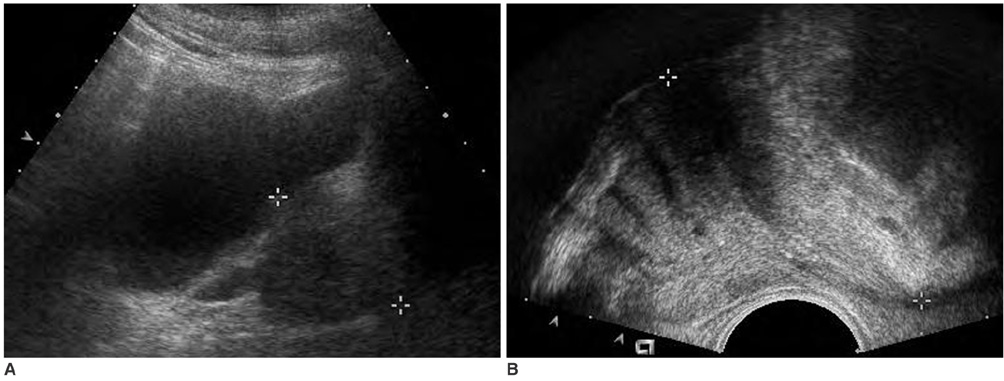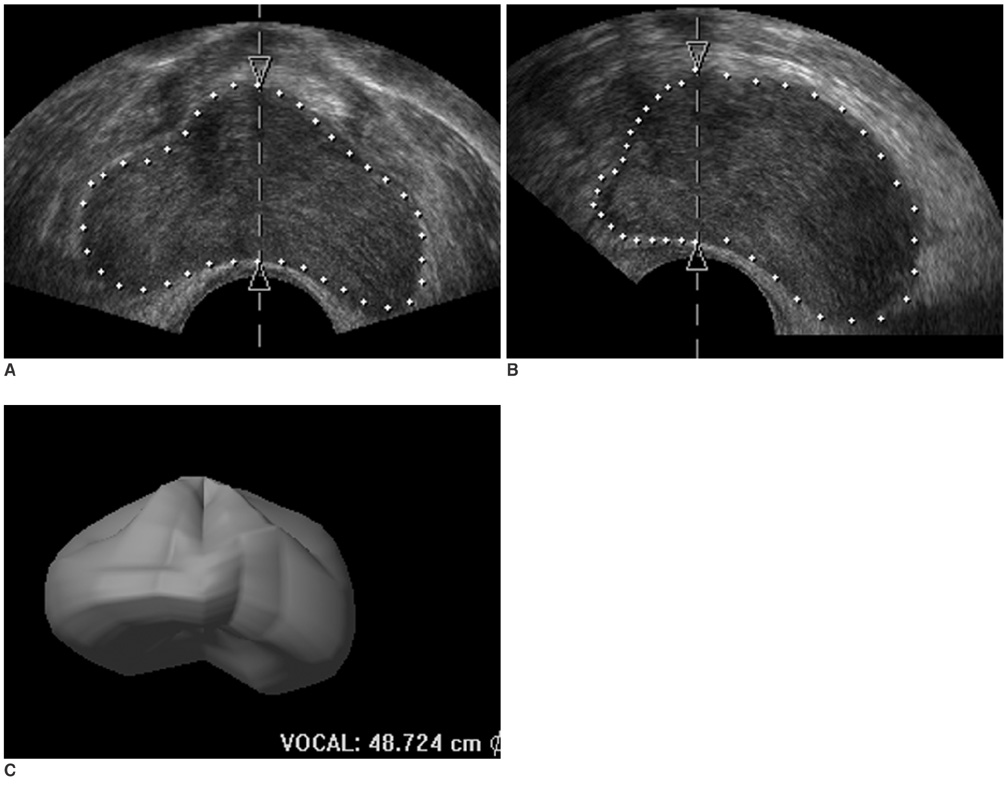Korean J Radiol.
2008 Apr;9(2):134-139. 10.3348/kjr.2008.9.2.134.
Correlations between the Various Methods of Estimating Prostate Volume: Transabdominal, Transrectal, and Three-Dimensional US
- Affiliations
-
- 1Department of Radiology, DongGuk University International Hospital, Goyang, Korea. kimsh@duih.org
- 2Department of Radiology, Seoul National University College of Medicine, Seoul, Korea.
- KMID: 1098192
- DOI: http://doi.org/10.3348/kjr.2008.9.2.134
Abstract
OBJECTIVE
To evaluate the correlations between prostate volumes estimated by transabdominal, transrectal, and three-dimensional US and the factors affecting the differences. MATERIALS AND METHODS: The prostate volumes of 94 consecutive patients were measured by both transabdominal and transrectal US. Next, the prostate volumes of 58 other patients was measured by both transrectal and three-dimensional US. We evaluated the degree of correlation and mean difference in each comparison. We also analyzed possible factors affecting the differences, such as the experiences of examiners in transrectal US, bladder volume, and prostate volume. RESULTS: In the comparison of transabdominal and transrectal US methods, the mean difference was 8.4 +/- 10.5 mL and correlation coefficient (r) was 0.775 (p < 0.01). The experienced examiner for the transrectal US method had the highest correlation (r = 0.967) and the significantly smallest difference (5.4 +/- 3.9 mL) compared to the other examiners (the beginner and the trained; p < 0.05). Prostate volume measured by transrectal US showed a weak correlation with the difference (r = 0.360, p < 0.05). Bladder volume did not show significant correlation with the difference (r = -0.043, p > 0.05). The comparison between the transrectal and three-dimensional US methods revealed a mean difference of 3.7 +/- 3.4 mL and the correlation coefficient was 0.924 for the experienced examiner. Furthermore, no significant difference existed between examiners (p > 0.05). Prostate volume measured by transrectal US showed a positive correlation with the difference for the beginner only (r = 0.405, p < 0.05). CONCLUSION: In the prostate volume estimation by US, experience in transrectal US is important in the correlation with transabdominal US, but not with three-dimensional US. Also, less experienced examiners' assessment of the prostate volume can be affected by prostate volume itself.
MeSH Terms
Figure
Cited by 1 articles
-
The Relationships between Thyroid Hormone Levels and Lower Urinary Tract Symptoms/Benign Prostatic Hyperplasia
Jun Ho Lee, Yeon Won Park, Sung Won Lee
World J Mens Health. 2019;37(3):364-371. doi: 10.5534/wjmh.180084.
Reference
-
1. Huang Foen Chung JW, de Vries SH, Raaijmakers R, Postma R, Bosch JL, van Mastrigt R. Prostate volume ultrasonography: the influence of transabdominal versus transrectal approach, device type and operator. Eur Urol. 2004. 46:352–356.2. Styles RA, Neal DE, Powell PH. Reproducibility of measurement of prostatic volume by ultrasound. Comparison of transrectal and transabdominal methods. Eur Urol. 1988. 14:266–269.3. Gilja OH, Thune N, Matre K, Hausken T, Odegaard S, Berstad A. In vitro evaluation of three-dimensional ultrasonography in volume estimation of abdominal organs. Ultrasound Med Biol. 1994. 20:157–165.4. Chang FM, Hsu KF, Ko HC, Yao BL, Chang CH, You CH, et al. Three-dimensional ultrasound assessment of fetal liver volume in normal pregnancy: a comparison of reproducibility with two-dimensional ultrasound and a search for a volume constant. Ultrasound Med Biol. 1997. 23:381–389.5. Riccabona M, Nelson TR, Pretorius DH, Davidson TE. In vivo three-dimensional sonographic measurement of organ volume: validation in the urinary bladder. J Ultrasound Med. 1996. 15:627–632.6. Riccabona M, Nelson TR, Pretorius DH, Davidson TE. Distance and volume measurement using three-dimensional ultrasonography. J Ultrasound Med. 1995. 14:881–886.7. Hu N, Downey DB, Fenster A, Ladak HM. Prostate boundary segmentation from 3D ultrasound images. Med Phys. 2003. 30:1648–1659.8. Aarnink RG, De La Rosette JJ, Debruyne FM, Wijkstra H. Reproducibility of prostate volume measurements from transrectal ultrasonography by an automated and a manual technique. Br J Urol. 1996. 78:219–223.9. Terris MK, Stamey TA. Determination of prostate volume by transrectal ultrasound. J Urol. 1991. 145:984–987.10. Blanc M, Sacrini A, Avogadro A, Gattamorta M, Lazzerini F, Gattoni F, et al. Prostatic volume: suprapubic versus transrectal ultrasonography in the control of benign prostatic hyperplasia. Radiol Med (Torino). 1998. 95:182–187.11. Kobayashi T, Kawahara T, Nishizawa K, Ogura K, Mitsumori K, Ide Y. Value of prostate volume measurement using transabdominal ultrasonography for the improvement of prostate-specific antigen-based cancer detection. Int J Urol. 2005. 12:881–885.12. Matthews GJ, Motta J, Fracehia JA. The accuracy of transrectal ultrasound prostate volume estimation: clinical correlations. J Clin Ultrasound. 1996. 24:501–505.13. Loeb S, Han M, Roehl KA, Antenor JA, Catalona WJ. Accuracy of prostate weight estimation by digital rectal examination versus transrectal ultrasonography. J Urol. 2005. 173:63–65.14. Sehgal CM, Broderick GA, Whittington R, Gorniak RJ, Arger PH. Three-dimensional US and volumetric assessment of the prostate. Radiology. 1994. 192:274–278.15. Wang Y, Cardinal HN, Downey DB, Fenster A. Semiautomatic three-dimensional segmentation of the prostate using two-dimensional ultrasound images. Med Phys. 2003. 30:887–897.16. Hodge AC, Fenster A, Downey DB, Ladak HM. Prostate boundary segmentation from ultrasound images using 2D active shape models: optimisation and extension to 3D. Comput Methods Programs Biomed. 2006. 84:99–113.17. Hamper UM, Trapanotto V, DeJong MR, Sheth S, Caskey CI. Three-dimensional US of the prostate: early experience. Radiology. 1999. 212:719–723.18. Bates TS, Reynard JM, Peters TJ, Gingell JC. Determination of prostatic volume with transrectal ultrasound: A study of intraobserver and interobserver variation. J Urol. 1996. 155:1299–1300.19. Sech S, Montoya J, Girman CJ, Rhodes T, Roehrborn CG. Interexaminer reliability of transrectal ultrasound for estimating prostate volume. J Urol. 2001. 166:125–129.20. Collins GN, Raab GM, Hehir M, King B, Garraway WM. Reproducibility and observer variability of transrectal ultrasound measurements of prostatic volume. Ultrasound Med Biol. 1995. 21:1101–1105.21. Tong S, Cardinal HN, McLoughlin RF, Downey DB, Fenster A. Intra- and inter-observer variability and reliability of prostate volume measurement via two-dimensional and three-dimensional ultrasound imaging. Ultrasound Med Biol. 1998. 24:673–681.
- Full Text Links
- Actions
-
Cited
- CITED
-
- Close
- Share
- Similar articles
-
- Errors of Prostate Volume between Actual Models and Transrectal Ultrasonographic Measurement
- Reliability of Transrectal Ultrasonography in the Prostate Volume Measurement
- Correlation Between Actual and Estimated Prostate Weight by Transrectal Ultrasonography with 14 Separate Methods of Volume Estimation in Patients with Benign Prostate Hyperplasia
- A Study of Correlations among International Prostate Symptom Score (IPSS), Volume of Total and Transition Zone of Prostate Measured by Transrectal Ultrasonography, Serum PSA Level in Benign Prostatic Hyperplasia
- The Correlation between Residual Prostatic Volume Ratio and Parameters of Prostate Volume and Clinical Parameters before and after Transurethral Resection of Prostate in BPH



